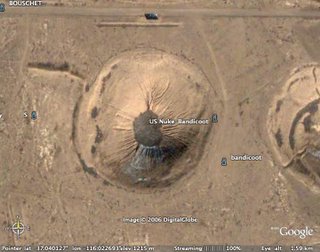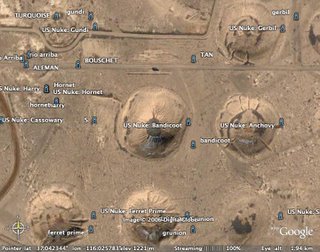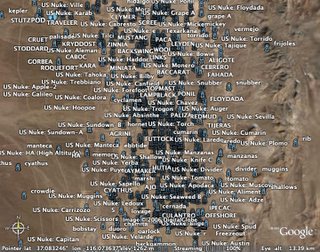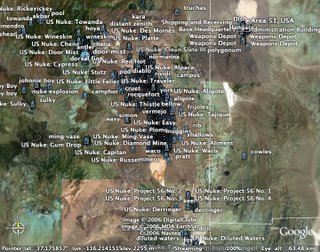As we were both experimenting with Google Earth tonight, Neal pointed out an area in Nevada to me. You can see the crater where an atomic bomb in the 100 kiloton range was tested:
Surrounding it are more test sites:
They sure felt the need to make sure these things would work:
It definitely makes you more certain that Eisenhower was on to something when he talked about a military-industrial complex in his farewell address:
In the words of Ike: “Every gun that is made every warship that is launched every rocket fired, signifies, in the final sense, a theft from those who hunger and are not fed, those who are cold and are not clothed”
It really defies all belief, doesn’t it?
[Update: 5 November 2005] Here are some more of my posts on nuclear weapons.






According to Wikipedia
Between 1951 and 1992, there were a total of 925 announced nuclear tests at Nevada Test Site. 825 of them were underground (seismic data has indicated there may have been many unannounced underground tests as well). The site is covered with subsidence craters from the testing [1]. The Nevada Test Site was the primary testing location of American atomic bombs; only 129 tests were conducted elsewhere (many at the Pacific Proving Grounds in the Marshall Islands).
On July 17, 1962 the test shot “Little Feller I” of Operation Sunbeam became the last atmospheric test detonation at the Nevada Test Site. Underground testing of weapons continued until September 23, 1992, and although the United States did not ratify the Comprehensive Test Ban Treaty, the articles of the treaty are nevertheless honored and further tests have not occurred. Tests not involving fission continue.
In a report by the National Cancer Institute, released in 1997, it was determined that ninety atmospheric tests at the Nevada Test Site deposited high levels of radioactive iodine-131 (5.5 exabecquerels) across a large portion of the contiguous United States, especially in the years 1952, 1953, 1955, and 1957—doses large enough, they determined, to produce 10,000 to 75,000 cases of thyroid cancer. In 1993, residents living near the Nevada Test Site were included in the Radiation Exposure Compensation Act, 1,375 claims were honored (1,121 were denied). As of 2004, the test site offers public tours on approximately a monthly basis, although the taking of souvenir material is prohibited.
Interesting… and scary. Like the details of the Teller-Ulam design, such as they are known.
Speaking of scary photos, here’s one of a MIRV test.
For the uninitiated, a MIRV is a (usually nuclear-tipped) missile that is capable of delivering multiple, independently targeted nuclear weapons into a theatre of operations. Each warhead could be set to strike a different city or missile base, greatly multiplying the potential destructive power of a single missile.
The negotiations on the use of MIRVs made up a critical component of nuclear limitation talks between the Americans and Soviets during the later decades of the Cold War.
Guess Ike would have been tarred and feathered and “rode outta town on a rail” today. When I was teaching Advanced Placement Government & Politics, students found it hard to believe that a Republican military-man President could have uttered such a statement. Great warning, though, Ike. Shame no one heeded it.
Terrific series of photos, btw.
This post is discussed on this rocketry related blog.
“As Ed Grothus will tell you, an atomic bomb looks like a soccer ball. The central core of the bomb is made of a radioactive metal such as plutonium or uranium that’s constantly sending off alpha particles. Around it are placed hexagonal and pentagonal explosive charges that look like the faces of a soccer ball.
To detonate the bomb, these charges are simultaneously set off. The key word, here, is simultaneously; in order to work, the charges have to detonate within a few hundred millionths of a second of one another. Designing the charges and the detonation mechanism were two of the major achievements of the Manhattan Project.
When the charges are detonated, they compress the radioactive core very fast and very hard, which causes it to become smaller and denser — more massive, in other words. Past a certain point, this causes a chain reaction, in which the nucleus of the plutonium atoms begin to split. This releases massive amounts of both gamma radiation and kinetic energy in a matter of milliseconds.
In other words, a nuclear explosion.”
(Link)
Nuking Mississippi
It really happened in the 1960s. Called (for some reason) Project Dribble, the purpose was to give U.S. scientists experience in detecting underground nuclear tests in the Soviet Union. The first blast, a 5.3 kiloton bomb, took place in 1964 at the bottom of a 2,710-foot shaft 28 miles southwest of Hattiesburg and four miles northeast of Baxterville. The second bomb, much smaller, was exploded two years later within the cavity created by the first blast. (To be sure, these were only two of well over a thousand documented nuclear tests by the United States, with the vast majority taking place in Nevada.)
Since this page seems to get so many hits from people interested in all things defence related, I will put a link here to the report I prepared for the Canadian Department of National Defence. As part of the research, eight other UBC students and I visited NORAD, USNORTHCOM, the Air Force Space Command, and the Air Force Academy:
Common Threats, Joint Responses: the Report of the 2005 North American Security Cooperation Assessment Student Tour (PDF)
Eisenhower warns of the military industrial complex.
“Until the latest of our world conflicts, the United States had no armaments industry. American makers of plowshares could, with time and as required, make swords as well. But now we can no longer risk emergency improvisation of national defense; we have been compelled to create a permanent armaments industry of vast proportions. Added to this, three and a half million men and women are directly engaged in the defense establishment. We annually spend on military security more than the net income of all United States corporations.
This conjunction of an immense military establishment and a large arms industry is new in the American experience. The total influence – economic, political, even spiritual – is felt in every city, every Statehouse, every office of the Federal government. We recognize the imperative need for this development. Yet we must not fail to comprehend its grave implications. Our toil, resources and livelihood are all involved; so is the very structure of our society.
In the councils of government, we must guard against the acquisition of unwarranted influence, whether sought or unsought, by the military-industrial complex. The potential for the disastrous rise of misplaced power exists and will persist.
We must never let the weight of this combination endanger our liberties or democratic processes. We should take nothing for granted. Only an alert and knowledgeable citizenry can compel the proper meshing of the huge industrial and military machinery of defense with our peaceful methods and goals, so that security and liberty may prosper together.”
Atomic Test Effects in the Nevada Test Site Region
In 1955 the giant mushrooms sprouted in abundance at the Nevada Test Site north of Las Vegas. A total of fourteen fission devices were detonated, with yields as high as 43 kilotons. The “Desert Rock VI” exercise exposed 8000 troops to nuclear blasts to train them for combat operations on the nuclear battlefield. This document was distributed in January 1955 to those living near the Nevada Test Site to prepare them for the 1955 test series. Illustrated with delightful 1950s line art, it includes such sage advice as, “Your best action is not to be worried about fall-out.” and “We can expect many reports that ‘Geiger counters were going crazy here today.’ Reports like this may worry people unnecessarily. Don’t let them bother you.”
Here is an especially poignant demonstration of a case where money was wasted on nuclear weapons, while it could have been helping to alleviate severe poverty: India has built a nuclear submarine, capable of launching ballistic missiles.
Soviet nuclear tests leave Kazakh fallout
Decades of Soviet nuclear testing on the steppes of Kazakhstan have been blamed for an alarming number of health problems suffered by residents in the area.
Now scientists are trying to determine whether the victims are passing on faulty genes to their children, the BBC’s Rayhan Demytrie reports.
…
The testing continued for 40 years. Nearly 500 nuclear explosions were carried out. More than 100 of them were above-ground devices that sent nuclear fallout far beyond the test area.
At the time, thousands of people who lived within a 300,000 sq km territory surrounding the Polygon were exposed to high levels of radiation.
Amchitka Nuclear Test Videos
By Effigy2000 on tests
Back in the early 1960s, Amchitka, a volcanic, tectonically unstable island in the Rat Islands group of the Aleutian Islands in southwest Alaska was selected by the United States Atomic Energy Commission to be the site for underground detonations of nuclear weapons. Three such tests were carried out and, thanks to Youtube, you too can watch some declassified US Government Amchitka test films. The first, named Long Shot, was an 80-kiloton blast (video) and was followed by Milrow (1-megaton) (video) and Cannikin (said to be under 5-megaton) (video). There’s also a declassified video that discusses the program at Amchitka in more detail.
…
Incidentally, Greenpeace was born out of opposition to the tests at Amchitka. Also, the Wikipedia article on the island, which is decent.
Thanks for sharing the screenshots. I looked at GoogleEarth earlier this year to see the proving grounds and I couldn’t find a way to make it show all the names of the nuke tests so this is really handy.
One of the default data layers within Google Earth includes the test names associated with the craters. Just try turning various ones on until they appear.
Today, on ARTE television, the film HIROSHIMA was aired and the scene that was most worrying to me is where James Franck tries to get over the point that, while the short-term military benefits (forcing the Japanese Tenno to concede defeat and submit surrender) might seem huge from the then-present standpoint, they would be dwarfted by the haunt of the arms-race the first demonstration of the feasibility of an atomic bomb would unleash… and is disregarded, with the unevitable consequence that at the beginning of the third millennium AD, more and more states are unlocking the pandora’s box nuclear weapons constitute. While even though more than 23000 nuclear warheads are believed to exist, the actual outbreak of a nuclear war seems relatively unlikely .
Much more disastrous is what Eisenhower’s statement “Every gun that is made every warship that is launched every rocket fired, signifies, in the final sense, a theft from those who hunger and are not fed, those who are cold and are not clothed” is reflecting: the 1.4 trillion US Dollars ANNUALLY spent on military expenditures could by FAR be better invested in providing nutrition to the poor, knowledge to the illiterate and building infrastructures where most needed.
What a terrible waste of time, money and effort this nuclear test program was…
“In the absence of major conflict, current or foreseeable, between the U.S. and any other nuclear-weapons state, these reduced but still excessive numbers of weapons are a burden and a danger, disconnected from the promising realities of the post-Cold War world. They are expensive, costing the United States alone more than $50 billion a year to maintain – although such a large allocation to U.S. defence contractors may partly explain why the nuclear arsenal continues to be held a such a high level long after the end of the Cold War. “By way of comparison,” wrote the nuclear-stockpile expert Stephen Schwartz, “the 2008 nuclear weapons-related ‘budget’ exceeds all anticipated government expenditures on international diplomacy and foreign assistance ($39.5 billion) and natural resources and the environment ($33 billion). It is nearly double the budget for general science, space and technology ($27.4 billion), and it is almost fourteen times what the U.S. Department of Energy (DOE) has allocated for all energy-related research and development.””
Rhodes, Richard. The Twilight of the Bombs: Recent Challenges, New Dangers, and the Prospects for a World Without Nuclear Weapons. (2010) p.284 (hardcover)
is there a KLM file for all the test sites?
here is a side story that a group of brain tumor survivors of a tumor that develops in the womb…has raised some questions as to when and where they were born…if a test was conducted?
we are making a KLM file of where the survivors where born….
http://youtu.be/cm30zLI2M3I
“The next attempt at Bluegill is destroyed on the launch pad. Severe plutonium contamination results from the warhead’s safe destruction.” https://www.youtube.com/watch?v=_AJPpHnBJiY
Eight countries. 2,054 nuclear tests. 70 years – mapped – Washington Post
Do you have the Google Earth .kmz file from the pictures of the NTS (NNSS) nuke craters?
Thanks!
I didn’t need any extra files – these were labeled in Google Earth when I first looked at them.